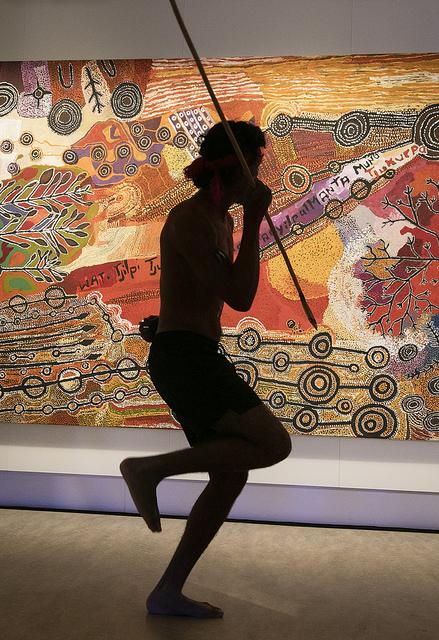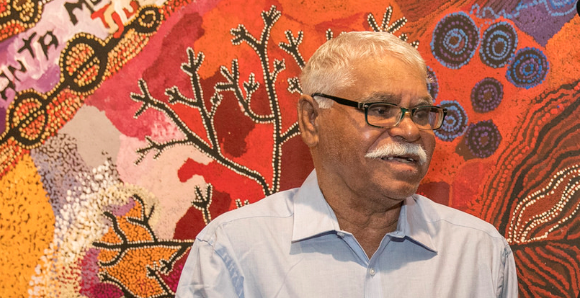'There was an ocean of blood'

“When I’m in here, I feel my spirit is with them … We will cry together.”
It’s a grey, wet day in Canberra and Frank Young has travelled from the Anangu Pitjantjatjara Yankunytjatjara (APY) lands in South Australia with his fellow artists to see their work take pride of place at the Australian War Memorial.
“An ocean of blood has been lost for Australia,” Mr Young said. “We are very pleased and very proud to come here … and to remember our people who fought for our Country.
“It is one of the most important responsibilities: looking after Country, protecting Country, and keeping Country safe. The ancestors handed down this responsibility, and it is as important today as it was hundreds of years ago.
“Together we are remembering and thinking about the soldiers, the Indigenous and non-Indigenous soldiers who … shed their blood … who died to defend our County. And we remember them. We remember them with a little bit of a sorrowful heart, but we remember them.”
Mr Young is chairman of the APY Executive Board. In late 2016, Memorial Director Dr Brendan Nelson commissioned the APY Art Centre Collective to create a work depicting the importance of defence of Country to Aboriginal Australians.
The resulting work, Kulatangku angakanyini manta munu Tjukurpa (Country and Culture will be protected by spears), was created by 19 senior male artists from 10 communities over a four-day period.
The painting is now on permanent display in the Orientation Gallery opposite the bullet-ridden landing boat that took men of the 13th Battalion ashore at Gallipoli on 25 April 1915.
Memorial Director Dr Brendan Nelson said the positioning of the work was particularly significant.
“There are four million objects in the collection of this institution: the most precious, which cannot have a value placed upon it, is that bullet-ridden Gallipoli landing boat. And right opposite hangs this painting,” Dr Nelson said.
“Proud Australians are familiar with Gallipoli and its place in our nation’s birth rites. But amongst those who landed were the first Australians.
“Only four or five generations after the arrival of the First Fleet and all the devastation it would mean for Aboriginal Australia, they denied their Aboriginality to fight and die for the young nation that had taken so much from them.
“In this painting and its prominent display, we are reminded that we are all equal – irrespective of politics, race or religion, we are Australians. We are reminded that this place in which we reveal our nation’s soul, we honour those who in every sense have fought to defend land – Aboriginal land, our common land, our nation Australia.”

Frank Young: "It is a particular man that will risk his life for Country."
Mr Young spoke of the inherent connection to Country that inspired the work and said he was immensely proud that the painting represented all Indigenous soldiers and put the spotlight on them.
“It’s really, really good for my people and for all of the people, for Australians,” he said.
“I am a spear maker. What we put in it, in the painting, is our story, our ancestors’ story, and … that really makes me proud … We own that story, but we all own that story, Australians all together.
“We remember that most of them were young – they didn’t have families when they went over – and yesterday, when we were with the Unknown Soldier, we recognised that he was one of all of them, and he was one of us, he was us, he fought for us, and we remember that when we said a prayer, and we continue to remember that.
“It’s a story about Australia and all of our stories … We sometimes get sorry about what people did – it makes us cry – but we can think about not only our people, but white people who fought for our Country ... white and black together.
“It is a particular man that will risk his life for Country. Since the Boer War Aboriginal soldiers have fought alongside so many non-Indigenous soldiers, together with one goal, to protect this Land.”